|
Rispondi |
Messaggio 1 di 7 di questo argomento |
|
LA PRECESION DE LOS EQUINOCCIOS (MOVIMIENTO DE 47 GRADOS) TAMBIEN TIENE UN NEXO KAVALISTICO CON EL SHABBAT (CUARTO MANDAMIENTO/SEPTIMO DIA/NUMERO 47)-DRACO TIENE FORMA DE SERPIENTE

47 (CUARTO MANDAMIENTO CON REFERENCIA AL SEPTIMO DIA)
EL SIGNO $, EN EL CONTEXTO AL TABERNACULO SIMBOLIZA APARENTEMENTE EL MOVIMIENTO RELATIVO DEL SOL A LO LARGO DE LAS CONSTELACIONES QUE TIENE FORMA DE SERPIENTE. VEMOS QUE LA POSICION DE LA VIRGEN EN EL CENTRO ENTRE LAS DOS COLUMNAS TIENE ORIGEN CIENTIFICO YA QUE LA CURVA CRUZA EL ECUADOR EN PISCIS Y VIRGO.

Vemos tambien en la grafica que hay un movimiento circular en el centro que es de 47 grados. En este contexto la "PRECESION DE LOS EQUINOCCIOS" TAMBIEN TIENE UN DISEÑO SABATICO Y EN FUNCION AL NUMERO DE ORO ya que sabemos que SABADO=SABIDURIA=SOPHIA=PHI=NUMERO DE ORO. LA CUPULA CATOLICA APARENTEMENTE ES UNA REFERENCIA A LA PRECESION DE LOS EQUINOCCIOS. VEMOS QUE TODO EL SISTEMA TIENE UN FUERTE NEXO SABATICO EN EL CONTEXTO AL CUARTO MANDAMIENTO CON REFERENCIA AL SEPTIMO DIA (47)
CATOLICO/CAT-OLICO/CAT-EDRAL/CAT/GATO-EL OJO DEL GATO TIENE LA MISMA FORMA QUE LA DEL SEXO FEMENINO "VESCICA PISCIS"
|
|
|
 Primo
Primo
 Precedente
2 a 7 di 7
Successivo
Precedente
2 a 7 di 7
Successivo
 Ultimo
Ultimo

|
|
Rispondi |
Messaggio 2 di 7 di questo argomento |
|
LAS DOS COLUMNAS DEL TABERNACULO Y DEL TEMPLO DE SALOMON, JACHIN Y BOAZ, EQUIVALEN A LOS PIES DE CRISTO

| gize in Simple Gematria Equals: 47 |
( |
g
7 |
i
9 |
z
26 |
e
5 |
) |
| john in Simple Gematria Equals: 47 |
( |
j
10 |
o
15 |
h
8 |
n
14 |
) |
| grail in Simple Gematria Equals: 47 |
( |
g
7 |
r
18 |
a
1 |
i
9 |
l
12 |
) |
EL SECRETO DEL NUMERO 47, INTERRELACIONADO CON FATIMA, TIENE REFERENCIA A LA DIFERENCIA EN GRADOS ENTRE LOS TROPICOS DE CANCER/GEMINIS Y CAPRICORNIO/SAGITARIO. RECORDEMOS QUE DICHOS TROPICOS ESTAN A 23:5 GRADOS DEL ECUADOR. SUMANDO DOS VECES ESA CIFRA TENEMOS 47. OBSERVEN QUE INCLUSO LA INDEPENDENCIA DE EEUU 4 DE JULIO INCLUSO ESTA EN CLAVE 4/7. Concretamente las dos columnas de JACHIN Y BOAZ QUE ESTABAN FRENTE AL TABERNACULO Y DEL TEMPLO DE SALOMON ESTABAN UBICADAS JUSTAMENTE A LA POSICION DEL SOL EN LOS SOLSTICIOS, OSEA EL 21 DE JUNIO Y EL 21 DE DICIEMBRE, EN CAMBIO EL CENTRO, ENTRE LAS MISMAS EQUIVALEN A LOS EQUINOCCIOS, OSEA EL 21 DE MARZO Y 21 DE DICIEMBRE. EN ESTE CONTEXTO DETRAS DE LA INDEPENDENCIA DE EEUU HAY UN FUERTE NEXO CON CRISTO, MARIA MAGDALENA Y EL GRIAL. EL DISEÑO DE GIZE ESTA JUSTAMENTE BASADO EN ESTAS PREMISAS EN EL CONTEXTO A QUE ES JUSTAMENTE LA CONSTELACION DE ORION (TRES PIRAMIDES) UBICADAS AL OESTE DE LA ESFINGE. ORION SIMBOLIZA AL HIJO DEL HOMBRE. ESTO EXPLICA DEL PORQUE LA UBICACION DE LA VIRGEN (VIRGINIDAD ESPIRITUAL/MARIA MAGALENA) UBICADA ENTRE LAS DOS COLUMNAS DE LOS TEMPLOS CATOLICOS. EL MENSAJE ES OBVIO Y ESTA EN CONTEXTO A BETANIA CUANDO LA MISMA UNGIO LOS PIES (DOS COLUMNAS) DE CRISTO. LA PIRAMIDE CENTRAL SIMBOLIZA AL GRIAL. EL MISMO CUERPO HUMANO ESTA DISEÑADO CON ESTE PATRON YA QUE POR EL MIEMBRO MASCULINO SE ORINA/ORION PI-PI. ESTA TODO CODIFICADO. SEGUN 2 CORINTIOS 5 (LIBRO NUMERO 47 DE LA TORA) NUESTRO CUERPO TAMBIEN ES TABERNACULO Y TEMPLO DE YHWH.

SIRIUS MARKED THE FLOODING OF THE NILE AND THE DOG DAYS OF SUMMER
|
|
|
|
Rispondi |
Messaggio 3 di 7 di questo argomento |
|
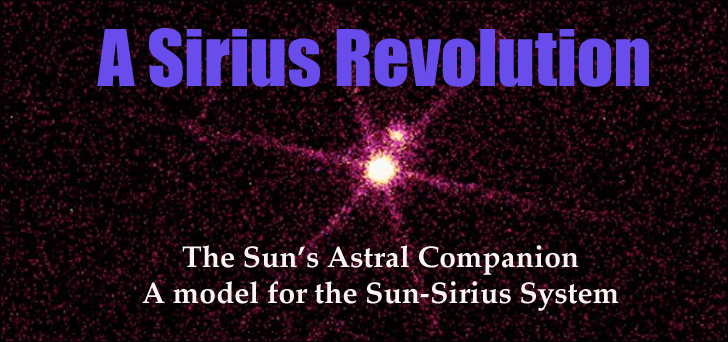
 By William Brown By William Brown
A Companion to our Sun?
The vast majority of observable stars are binary or multiple star systems. In these systems, two or more stars share a common focus of revolution and are gravitationally bound to each other in defined orbits. This is such a common observation such that the gravitational interaction of multiple stars appears to be the "normal" mode of stellar system formation.
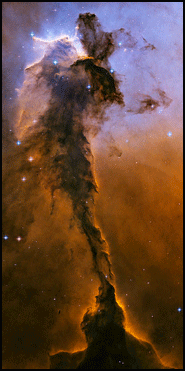 This is logical because stars are formed in nebulae that are "stellar nurseries" [right] where great conglomerates of light elements formed during the Big Bang while heavy elements were synthesized in the heart of giant, primordial stars, and were ejected upon their disruption. Special note should be made of the many complex organic compounds permeating such nebulae [1,2], because of the implications for cosmic biogenesis and panspermia -- theories which hold that life has an extrasolar origenesis. This is logical because stars are formed in nebulae that are "stellar nurseries" [right] where great conglomerates of light elements formed during the Big Bang while heavy elements were synthesized in the heart of giant, primordial stars, and were ejected upon their disruption. Special note should be made of the many complex organic compounds permeating such nebulae [1,2], because of the implications for cosmic biogenesis and panspermia -- theories which hold that life has an extrasolar origenesis.
The Spire [right]. This column of star forming material is 57 trillion miles long.
The close proximity of stars to each other upon formation clearly involves a high probability for gravitational binding, assuming that astral formations aren't directly driven by binary interactions (which could very well be the case). Intellectually this establishes the basis for a dual-star interaction within our Solar System. It is generally presumed that the Sun is a unique exception to this commonly observed phenomenon, however, observational evidence suggests that the Sun is moving in a defined orbit around a companion system of stars.
Evidence is plentiful for the support of a model involving the interaction of multiple stars in our solar system and will be presented in this article. Also, multiple flaws abound in the centuries-old models of heliocentricism that were formed before it was understood that the solar system moves through space.
Dark Star or Nemesis?
Is the idea of a solar companion to our Sun unprecedented? Not at all, in fact there have been numerous scientific publications examining the evidence for a "dark star", literally speaking, to which our Sun could be gravitationally bound in a definite orbit [3]. This alternate dark star is known as Nemesis, and its proposition comes primarily from observed perturbations of orbiting objects such as the planet-sized Kuiper belt object named Sedna [4].
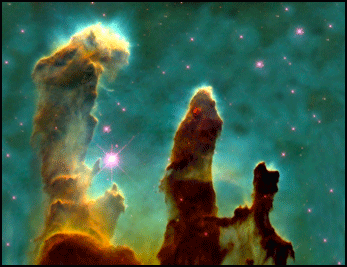
The Pllars of Creation - A Hubble Telescope image of the Eagle Nebula within the constellation Serpens. The light of super-massive stars can be seen shining forth.
Walter Cruttenden of the Binary Star research institute has propounded that a solar companion need not necessarily be of the "dark star" variety. Given the paucity of empirical observations and measurements of the movement of many of the bright stars within our own local galactic sector, it is with some justification that visible stars be examined to see if any may share a common focal point with our own Solar System [5]. At the heart of the poly-solar system theory is a simplification of the mechanics of constellation precession (precession observable) with a more logical model, one that does not rely on a putative wobble of the Earth but instead explains the precession observable with the movement of the Solar System itself.
| Precession
In astronomy, axial precession is a gravity-induced, slow and continuous change in the orientation of an astronomical body's rotational axis. In particular, it refers to the gradual shift in the orientation of Earth's axis of rotation, which, like a wobbling top, traces out a pair of cones joined at their apices in a cycle of approximately 26,000 years (called a Great or Platonic Year in astrology).
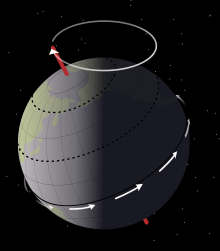 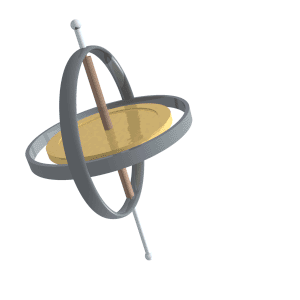
Earth's precession was historically called precession of the equinoxes because the equinoxes moved westward along the ecliptic relative to the fixed stars, opposite to the motion of the Sun along the ecliptic. This term is still used in non-technical discussions, that is, when detailed mathematics are absent. Historically, Hipparchus is credited with discovering precession of the equinoxes. The exact dates of his life are not known, but astronomical observations attributed to him by Ptolemy date from 147 BC to 127 BC.
The above video explains the Precession of Equinox and introduces some new and old theories.
|
Who is our Sun's twin?
Is there a candidate for binary revolution among the visible stars? Logically we could begin with the closest star to our own, which is Alpha Centauri. At a distance of 4.37 light years, it is the third brightest star and, as is common, it is itself a binary system.
Another star that shows evidence of being gravitationally bound within the system and is called Alpha Proxima. Alpha Proxima is 0.2 light years from Alpha Centauri AB, about 400 times the distance of Neptune's orbit from the Sun. This shows that a dual or poly star system does not have to necessarily be in close orbital interaction. However Alpha Centauri lies at a declination of -60°, which is well out of the plane of the Solar System, and as such, has a near circumpolar motion in the sky.
A more suitable candidate would be a star closer to the plane of the Solar System, or celestial equator. Sirius meets this criteria, at a declination of -17°. It is also the brightest star in the night sky, three times brighter than Alpha Centauri and twice as bright as the next brightest star Canopus. Sirius is also the 5th closest system of stars to our own [6]. More significant is the fact that The Sirius Research Group has been recording the position of Sirius for approximately 20 years now and has not recorded any measurable alteration in its location relative to the precession [7].
Imagine that you are holding hands with a friend, face to face. If you both began to spin around in a circle, your friend would appear to be stationary, while everything around them would appear to be spinning very rapidly. Your joined hands would be the focal point of the revolving motion. While the surrounding environment would not be spinning around, it would appear to be from you perspective.
This illustrates how the perception of both you and your friend can be very illusionary -- you see yourselves as relatively stationary while the background whirls around you. This is very similar to our situation with respect to observations of celestial motion between the Sun and its solar companions. Our observation of this phenomenon is more complex in that we must also factor in the orbital motion of the Earth and planets around the Sun.
Celestial bodies in our Solar System show harmonic resonance with the Sirius system. Pluto and Sedna are at an incline to the plane of the solar system of roughly 17°, the same as Sirius. Both have orbital periods of 250 years and 12,000 years, which are at 1:5 and 1:2 resonances with Sirius, respectively (12,000 years is roughly one half of the orbit of the Sun around Sirius, hence a 1:2 resonance).
Resonance is a criterion stipulated for any system of orbiting bodies, which is why planets and moons are often times tidally locked with their parent body, and is another reason why the hypothesis of a putative wobble is very unappealing. A wobble is indicative of dynamic instability, not harmonic resonance (think of a spinning top before it falls, it begins to wobble).
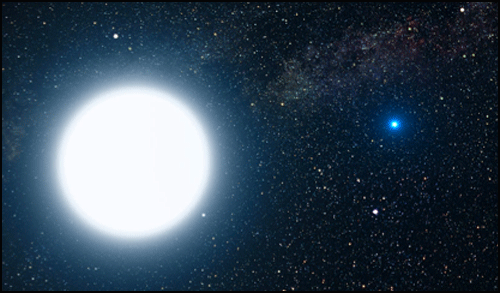
A Sirius Candidate
Sirius is a binary system. Sirius A is the highly visible star, but there is a companion known as Sirius B, first described in modern times by the Dogon tribe of Mali (Africa) and subsequently verified by the observational science of astronomers. The Dogon also described a third celestial body with characteristics of a neutron star. While a neutron wouldn't be visible in the same manner as Sirius B, the combined gravitational attraction of a neutron star, a white giant star and a white dwarf would certainly provide the gravitational force needed to keep the Sun bound at a distance of 8.6 light years. In fact, the presence of a neutron star is by no means necessary for the gravitational interaction of the Sun with Sirius.
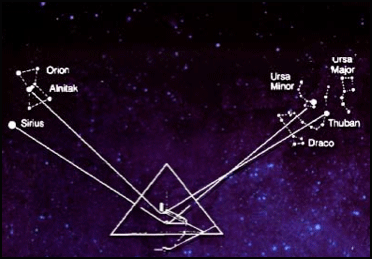
Historic and mythological descriptions of Sirius provides further insight into the nature of the relationship between the Sun and Sirius. A shaft leading from the Queens chamber of the Great Pyramid of Egypt was -- and still is -- aligned precisely with Sirius. Given the high probability that it was constructed that way, and considering that the pyramids form a star map in and of themselves, it shows how many epochs Sirius has been in a stationary position relative to the movement of the other stars.
When European philosophers first hypothesized that the Earth revolves around the Sun it was a radical and revolutionary idea of that era. Nicholas Copernicus developed the model and scientific explanation by which the Earth revolved around the Sun, and proponents of the model expounded it after its posthumous publication in 1543. The process of overturning the geocentric model of the Solar System, where the stationary Earth was at the center of the Universe, was not an easy venture and came to be known as the Copernican Revolution. Like most ideas that challenge the existing paradigm, it was not well received by most philosophers of the day. This is evident in the following discourse concerning a lecture given by Giordano Bruno at Oxford University for the Polish Prince Albert Alasco in 1583, (verbatim):
"When that Italian Didapper, who intituled himself Philotheus Iordanus Brunus Nolanus, magis elaborata Theologia Doctor, etc., with a name longer then his body, had in the traine of Alasco the Polish Duke, seene [sic] our University in the year 1583, his hart was on fire, to make himself by some worthy exploite, to become famous in that celebrious place. Not long after returning againe, when he had more boldly then wisely, got up into the highest place of our best and most renowned schoole, stripping up his sleeves like some juggler ... he undertook among very many other matters to set on foote the opinion of Copernicus, that the earth did goe round, and the heavens did stand still; wheras in truth it was his owne head which rather did run round, and his braines did not stand still..."[8]
As can be seen by this malicious retort, the best monds of Oxford did not consider the Copernican heliocentric model in the highest regards. Eventually with the development of science and its support of empirical observations, the Heliocentric model was adopted to explain the celestial mechanics of our Solar System.
Certain celestial movements could not be explained by the model however, such as the precession of the zodiacal constellations, whereby the stars associated with the constellations of the zodiac move retro-progressively across the sky over long epochs of time.
In precession there is a retrograde movement, which means that the stars of the Zodiac move backwards in relation to the overall progression of the celestial sphere. So while the Sun is observed to rise in a given constellation of the zodiac at a given date, say the constellation Pisces on the Spring Equinox of March 21st, over time it is observed that Pisces rises sooner and sooner each year. Eventually, after about 2150 years, the Sun is no longer rising in Pisces on March 21st, but is rising in a different constellation altogether, like Aquarius. This is a retro-progression because it is opposite of the apparent direction of the Sun within a single year, where the Sun moves in the opposite direction of the precession through the zodiacal band of stars, so from January to February the Sun appears to travel from Aquarius into Pisces.
This progression is due to the movement of the Earth around the Sun, and not the Sun around the Earth, as was purposed in the geocentric model. However the retro-progression cannot be explained by the movement of the Earth around the Sun, therefore, an additional revolving movement was introduced.
Since it was known that the Earth was tilted on its axis, it was hypothesized that the Earth wobbles around this axial tilt in a precise manner every 26,000 years. This would explain the precession of the Zodiac stars, as it takes about 2150 years for each Zodiac constellation to precede and there are 12 constellations (well there use to be until the introduction of the 13th constellation Ophiuchus into the Zodiac, which is a more harmonious configuration to the natural order) that equals approximately 26,000 years.
Problems with the wobble
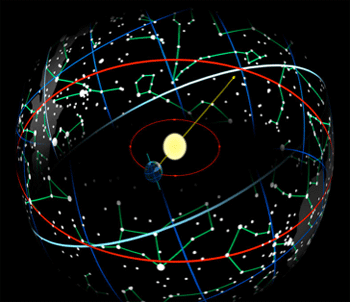 By what mechanism is a secondary retrograde rotation of the axis itself induced? The theory that was posited came to be known as Lunisolar Precession [right]. It was hypothesized that torque from the Sun and Moon supplied a force that perturbed the orientation of the axis, causing it to wobble. I call this the "Wobble Hypothesis". By what mechanism is a secondary retrograde rotation of the axis itself induced? The theory that was posited came to be known as Lunisolar Precession [right]. It was hypothesized that torque from the Sun and Moon supplied a force that perturbed the orientation of the axis, causing it to wobble. I call this the "Wobble Hypothesis".
When you take into account all the rotational motions and orbital paths of these three bodies (i.e. the Sun, Earth and Moon) it is staggering to think that a uniform force could be applied to generate a stable enough torque to maintain a 26,000 year periodicity through the precessional cycles.
It should be noted that this number -- 26,000 years -- is rounded off and is not a stable time-line for the precession. The actual precession proceeds with temporal fractionalization [9], where in measurements from 1900's to 1990 it increased from 25,800 years to 25,920 years. The phenomenon of temporal fractionalization, whereby time accelerates in fractals so that more cycles are fit into shorter periods, was well known to the Mayans and is an intrinsic part of their Calendars, regarded as some of the most accurate measurements of time to this day [10]. Furthermore the interactions of the numerous other celestial bodies of the solar system were not even considered, as well as the oblate geometry of the Earth, and as such the mathematical models have been continually altered in an attempt to manufacture a proper solution.
The history of the lunisolar precession model is one of problems, revisions, and the continuous addition of new inputs. Newtons' original equations did not work. d'Alembert, recognizing the earth was not a rigid body, made the first major changes, and many others since have added and changed dynamical inputs until the values have come very close to fitting the observable of approximately 50.3"p/y [50.3 arc seconds per year is a unit of astronomical measurement, it equals 30 degrees of precession about every 2000 years, 30 degrees being about equal to the diameter of the full moon]. The problem is that while current models are designed to closely approximate a fixed precession observable on a fixed date, the observed rate has been increasing at an increasing rate over the long term (100+ years), something that current models have been unable to predict. As predictability is a litmus test for the validity of a theory, the lunisolar theory is now undergoing increased scrutiny. [11]
This information by itself raises serious questions about the validity of the "Wobble Hypothesis". However the major flaw of this hypothesis comes from an examination of the static position of the star Sirius in relation to precession and its historical utilization as a marker for time in the Sothic Calendar of the Egyptians.

From Africa, where the Dogons live, the star Sirius disappears below the horizon and is out of sight for a couple of months; then it appears again on the morning of July 23, when it rises about one minute before the Sun. It appears bright ruby-red, just above the horizon, almost exactly due east. Sixty seconds later the Sun emerges. So you can see Sirius for just a moment, then it's gone. This is called the helical rising of Sirius, which was a very important moment for most of the ancient world, not just for the Dogons and Egypt.
This is the moment when Sirius and the Sun and the Earth are in a straight line across space. In Egypt, almost all the temples were aligned with this line, including the gaze of the Sphinx. Many of the temples had a tiny hole in the wall somewhere; then there would be another wall and another, going into some dim inner chamber. In that chamber there would be something like a cube or Golden Mean rectangle of granite sitting in the middle of the room with a little mark on it. At the moment of the heliacal rising of Sirius, a ruby-red light would strike the altar for a few seconds, which would begin their new year and the first day of the ancient Sothic calendar of Egypt. [12]
The periodicity of the helical rising of Sirius was such that the Egyptians based their calendar on it [right]. Every year for millennia the appearance os Sirius coincided with the flooding of the Nile, an event that remarakbly still happens to this day.
This fact alone betrays the blatant flaw in the current consensus model for the precession of the Zodiac. With the "Wobble Hypothesis", the Zodiac stars aren't actually moving; they are fixed in place. The apparent retrograde motion is only the result of the transient shift of the equinoxes. Therefore it receives it's much more common and well known description as "the Precession of the Equinoxes". In this consensus model, the equinoxes are occurring at different locations within the Earth's orbit around the Sun, and since they are occurring at different locations there is a different backdrop of stars.
The equinoxes and solstices are a function of the 23.6° tilt of the Earth's axis. When the tilt is facing the Sun, the Northern hemisphere is in summer because it is receiving more sunlight and there are more daylight hours -- the days are longer and the nights are shorter. When the tilt is away from the Sun, the Northern hemisphere is in winter. This is opposite for the Southern hemisphere. The midpoints between these two extremes are the equinoxes, where the length of day and night are equal.
The equinoxes retrogress because the tilt is changing its orientation to the Sun as it wobbles about. This causes the equinoxes, as well as the solstices to occur in different locations in the Earth€™s orbit [right]. The problem is that if the equinoxes and solstices were occurring at different locations then Sirius could not have a precise helical rising every July 23rd from the latitude of Egypt!
All of the equatorial backdrop of stars would retrogress with the wobble of the Earth, and thus Sirius would have a helical rising that regresses throughout the Year, occurring at all different seasons throughout the 26,000 year cycle (see figure 5). The only stars that would remain relatively fixed are those at the poles, although they would still have minor perturbations themselves. But his is not what is observed. As Jed Buchwald, professor of the history of science at Caltech, states:
"Sirius remains about the same distance from the equinoxes -- and so from the solstices -- throughout these many centuries, despite precession" [13].
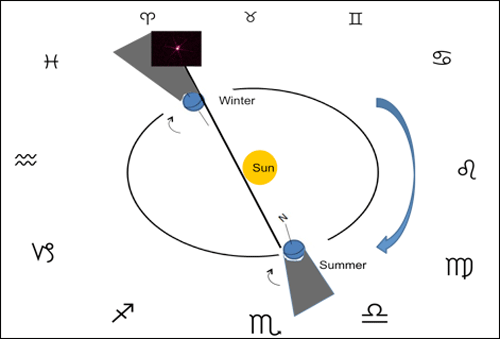
The Helical rising of Sirius in the summer, showing how the Sun and Sirius become aligned along the horizon of the Earth as it rotates into the light of the Sun. Similarly the Sun and Sirius are aligned in the winter as well, however, because Sirous is on the outside it appears directly above the Sun as it rises in the winter. This is the source of the Star of Bethlehem. It is the star Sirius.
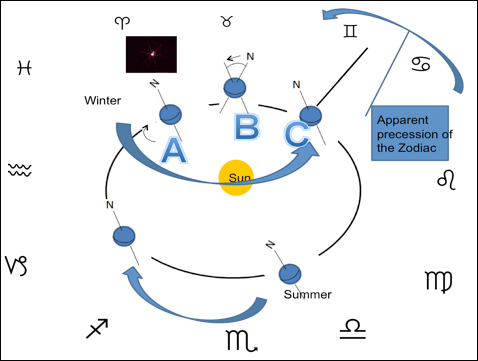
The Solstice would occur at A, but because of the retrograde wobble of the axis (b), winter now occurs at C.
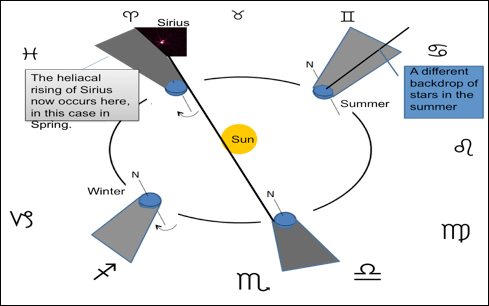
Figure 5: The wobble of the Earth's axis causes the seasons to occur at transient locations in the Earth's orbit during the cycle of the precession of the Zodiac. If the precession were due to the wobble, then Sirius would shift with the equatorial stars as well, and occur in a different season corresponding to the specific alignment.
These inconsistencies are resolved in the new precessional paradigm.
First off, the seasons do not regress with the precession of the Zodiac. They remain fixed in their location relative to the Sun. But not loci-static in the orbital revolution around Sirius. That is, seasons occur at different positions relative to Sirius (see figure 6). However the Sun's revolution around Sirius is so eccentric and long that perturbations in the position of Sirius are not perceived until the Sun reaches apastron. Apastron is the point in a star's orbit where it is furthest from its orbital companion, this is intrinsic to the nature of elliptical orbits. As the Sun revolves around Sirius, the zodiacal constellations shift location and appear to have a retro-progressional movement across the sky over epochs of time.

Figure 6: The Sun orbits around Sirius, and as it does so the backdrop of stars forming the Zodiac constellations change location. However the location of these seasons occur at the same position within the Earth's orbit around the Sun.
As the Sun passes through the apastron points approximately every 13,000 years, Sirius would indeed appear to have a precessional migration across the sky, until eventually the heliacal rising would occur in the winter (see figure 7). And this is fine, because it does not violate any historical recordings of the behavior of Sirius. In fact, a review of the highly advanced Babylonian astronomy shows that this was actually described.
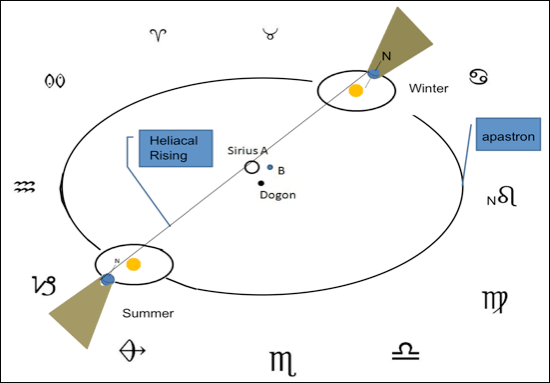
Figure 7: The term Nibiru is well known, and equally misunderstood. The Babylonians used it more as a descriptive term than a name representing a specific object. In Babylonian Astronomy it was used to describe a star -- not a planet -- as can be seen in the following examples from translations by Horowitz [14]: The Helical rising of Sirius as the Sun orbits it. Since the location of the solstices and the equinoxes are occurring at the same location within the Earth's orbit around the Sun, the helical rising is switched when the Sun reaches the opposite point in its orbit.
* He [Marduk in context] set fast the position of Nibiru to fix their [the stars] bounds."
*"...let Nibiru be the holder of the crossing place of the heaven and of the earth."
*...the red star which stands in the south after the gods of the night [the stars] have been finished, dividing the sky in half, this star is Nibiru, (i.e., Marduk)." (note it's a red star, and this is often how the Ancients described Sirius)
* "Nibiru is his [marduk's in context] star, which he made appear in the heavens ... The stars of heaven, let him [Nibiru] set their course; let him shepherd all the gods like sheep."
What can be seen clearly here is that the term nibiru is being used to describe a star, that this star sets the course of the other stars, that is to say that it is the source of their precession, and that it is the crossing point.
It is my supposition that Nibiru is referred to as a "crossing point" because when the Sun passed apastron and began its opposite revolution, Sirius would cross the sky. Not only did this crossing of Sirius mark the turning point in the Sun's orbit, but also the turning point in the Yuga cycles.
The new Sun-Sirius system model satisfies the observational behavior of Sirius and the constellations of the zodiac as they regress throughout the great cycle of 26,000 years. There is no need to introduce a "wobble" in the Earth's axis, induced by the action of 9 other celestial bodies -- a theory which is just a relic from a time when the motion of the Solar System was not yet conceived.
It would be sagacious not to place Sirius at the center of the Solar System, for in a fractal system there is no true center. The fractal nature of the Universe engenders its self-arrangement, or more apropos, the Universe is a holofractal graphic system [15]. Therefore there are many nested orbital interactions, going out as far as the local cluster of galaxies, which themselves have a focal point.
This is nothing new. Previous civilizations understood celestial mechanics at an advanced level, and the mathematical precision of their astronomical observations is a testament to this [16]. The reason why the Egyptians and many other civilizations of that era used Sirius as their marker for the passage of time is because they picked the most stable object as their reference point.
We choose the Sun as our reference point, and this is obviously highly inaccurate. Every 4 years a day has to be added to keep accurate time. But even Sirius was not accurate enough for the "Keeper's of Time", the Mayans. With their remarkably advanced astronomy they quickly detected the inaccuracies in using Sirius as a marker for the passage of time, and switched to an even more accurate cycle involving the Pleiades. There is however an even more stable reference point than the Pleiades and that is the Galactic center, which from the perspective of our galaxy is the ultimate center of rotation.
And indeed the Mayan's chose the Galactic Center as a reference point to mark the passage of time, which is evident as the Mayan Long Count ends with the galactic alignment of the Solar System on December 21st 2012. Therefore, the idea that the Earth orbits the Sun, or that the Sun orbits Sirius, or that Sirius orbits Alcyone and that Alcyone orbits the Galactic Nucleus, is not revolutionary -- it's just a rediscovery of lost knowledge.
|
|
|
|
Rispondi |
Messaggio 4 di 7 di questo argomento |
|
|
|
Whitney Houston ¿nueva víctima de los illuminati?Estamos tras la puerta del universo como bien decia Tesla, sobre el 3, 6, y el 9, hay que construir un conocimiento en base a estos conceptos, una buena forma y los Masones lo saben es a través de la geometria. http://es.wikipedia.org/wiki/Toro_(geometr%C3%ADa) Toro (geometría) Para otros usos de este término, véase Toro. En geometría, un toro es una superficie de revolución generada por una circunferencia que gira alrededor de una recta exterior coplanaria (en su plano y que no la corta). La palabra «toro» proviene del vocablo en latín torus, el cual en castellano significa «bocel» o «murecillo», que es una moldura redondeada de la basa, con forma de hogaza de pan.1 2 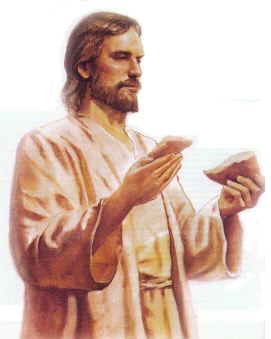 Si hacemos un corte longitudonal de Toro obtenemos la Vesica Piscis, como siempre los nombres no son elegidos por que si, Benicio del Toro, etc.
 |
Click para ampliar |
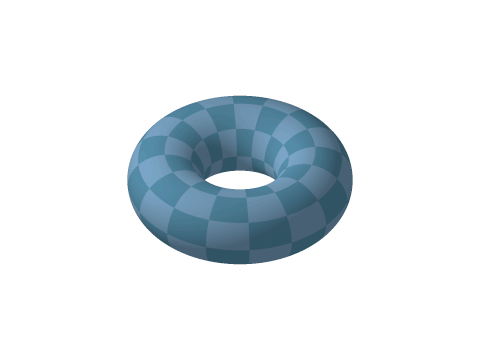 Animación mostrando un toro siendo cortado por un plano, creando Círculos de Villarceau. Ver Vesica Piscis. Juan 6.33 Porque el pan de Dios es el que baja del cielo, y da vida al mundo.
 |
Click para ampliar |
 En cuanto a los cubos de los hipercubos, al juntarse el 9 y el 6 claramente chocan los ejes de los hipercubos, esto en definitiva es lo que produce el fuego y energia para el nuevo ciclo, puedes apreciar como en la forma octogonal el 6 y el 9 rotan sin problemas formando la estrella de 8 puntas, en el octogono mantienen la maxima distancia durante el ciclo, la llamada era dorada que viene despues del cataclismo, codigo de las manzanas doradas en el jardin de las hermanas Hesperides. Estrella binaria - Wikipedia, la enciclopedia libreSistema binario girando reciprocamente en espiral, se puede apreciar de donde sale la forma geometrica del 6 y el 9, al colapsar los espirales esto números se juntan dando lugar a una nuevo ciclo de tiempo.  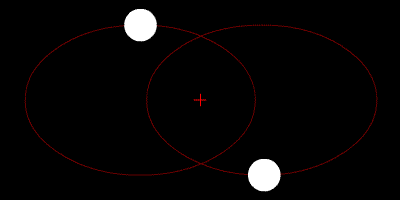 La nebulosa del ojo del gato es un sistema trinario parecido pero con una estrella en el medio, se puede apreciar que dentro de la vesica piscis hay una estrella, otras 2 la orbitan, de allí parte la singularidad, el codigo Mon de la Moon en Ingles Luna, codigo Da Vincia de la Mona Lisa, etc. De alli como fractales nuestros siete dias, que son las siete vidas del gato, etc.
 |
Click para ampliar |
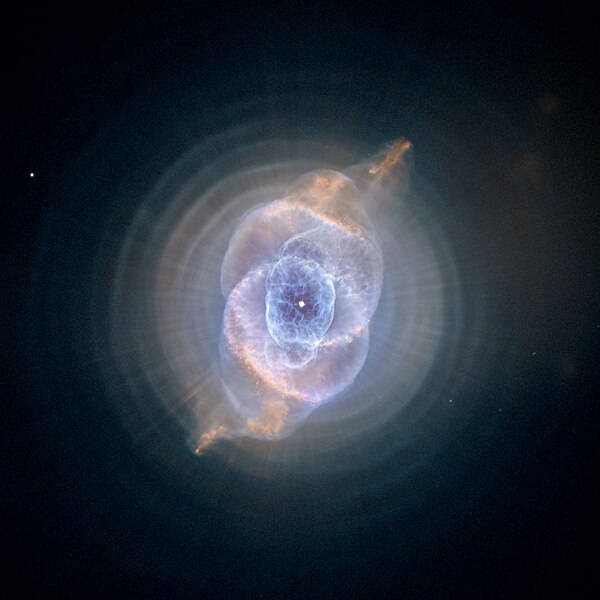 Construccion el heptragrama
 |
Click para ampliar |
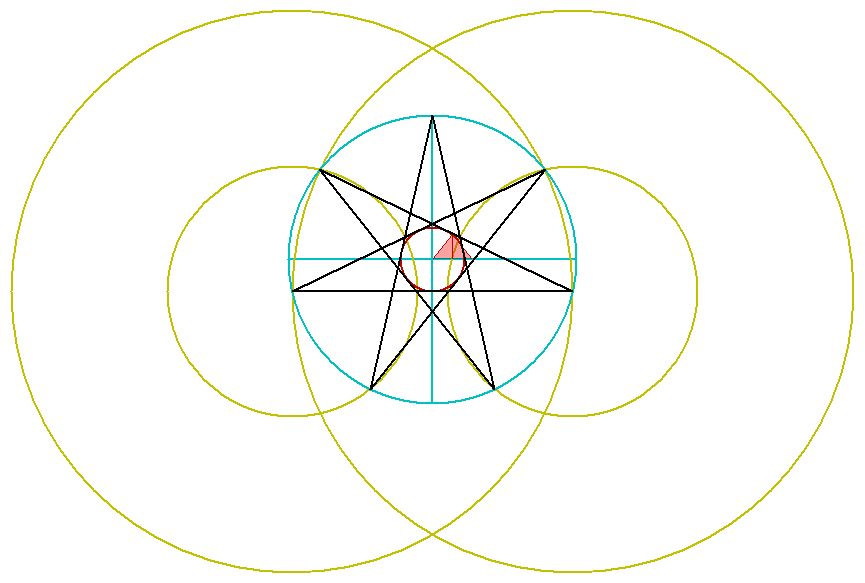
 |
Click para ampliar |
 En celeste tenemos enl heptagrama el cual coincide con el angulo de la gran piramide 360/7 =51.42 Podemos ver como la base el heptagrama es la gran piramide de Egipto, estos son los fractales del centro de la galaxia que producen nuestros siete dias, 28 dias del mes lunar, etc. Por lo tanto la gran piramide representa la singularidad geometrica, las bases representas los ciclos Alfa y Omega, cuando cambie nuestro espiral 6 a 9 y se inviertan la rotacion de los cubos, la precesion de los equinoccios llegara hasta la puerta de Leo, mas 90 grados llegamos a Omega, el mismo proceso a la inversa. Recordemos Omega - Libra - Lyra - las monedas de los imperios - Dios Apolo y su instrumento.
Última edición por IndigoMerovingio; 08-abr-2012 a las 17:18
|
|
|
|
|
Rispondi |
Messaggio 5 di 7 di questo argomento |
|
|
GOD/DOG
G (SEPTIMA LETRA)
O (QUINCEAVA LETRA)
D (CUARTA LETRA)
G-D=4/7 O 7/4 (INDEP. DE EEUU)
CUARTO MANDAMIENTO
SEPTIMO DIA (7 D)
Éxodo 20:8-11 8 Acuérdate del sabado para santificarlo. 9 Seis días trabajarás, y harás toda tu obra; 10 mas el séptimo día es reposo para Jehová tu Dios; no hagas en él obra alguna, tú, ni tu hijo, ni tu hija, ni tu siervo, ni tu criada, ni tu bestia, ni tu extranjero que está dentro de tus puertas. 11Porque en seis días hizo Jehová los cielos y la tierra, el mar, y todas las cosas que en ellos hay, y reposó en el séptimo día; por tanto, Jehová bendijo el día de reposo y lo santificó. (RV)
GOD/DOG
DOG (PERRO)=SIRIO
O=15 LETRA
15=6+9 (69 CANCER)=1111
(BINARIO)
11 (BINARIO)=3 (DECIMAL)
1111 EQUIVALE A 33
69=23X3
Sol-o-mon
Sun -15 - mon-key
Everything is Connected and there are no
coincidences
SIRIO (CAN MAYOR)
|
|
|
|
Rispondi |
Messaggio 6 di 7 di questo argomento |
|
Helena (mitología)
De Wikipedia, la enciclopedia libre
Para otros usos de este término, véase Helena. Helena ( Ἑλένη en griego antiguo), a veces conocida como Helena de Troya o Helena de Esparta, es un personaje de la mitología griega; su leyenda es aludida por casi todos los mitógrafos clásicos. Era considerada hija de Zeus y pretendida por muchos héroes debido a su gran belleza. Fue seducida o raptada por Paris, príncipe de Troya, lo que dio origen a la Guerra de Troya.
Nacimiento
Zeus, metamorfoseado en un cisne, sedujo a Leda y yació con ella la misma noche que Tindáreo, esposo de Leda y rey de Esparta. Como consecuencia de ello, Leda puso dos huevos; de uno nacieron Helena y Pólux, ambos inmortales (considerados hijos de Zeus), y del otro Clitemnestra y Cástor, mortales (considerados hijos de Tindáreo). De todas maneras, se consideraba a Cástor y Pólux como gemelos y se los conocía como Dioscuros. Otras hermanas de Helena fueron Timandra y Filónoe.
Otra tradición decía que Helena había nacido de la unión de Némesis y Zeus, transformados respectivamente en oca y cisne. El huevo que puso Némesis fue encontrado por un pastor que lo entregó a Leda. Del huevo nació Helena y Leda la cuidó como si fuera su auténtica madre.[1]
[editar] Rapto de Helena por Teseo y Pirítoo

Teseo llevándose a Helena. Ánfora ática de figuras rojas. Siglo VI a. C. Staatliche Antikensammlungen, Múnich.
Helena fue famosa por su belleza desde que era una niña. Un día, mientras realizaba un sacrificio a la diosa Artemisa, fue sorprendida y raptada por el héroe ateniense Teseo en compañía de su amigo Pirítoo. Tras capturarla, echaron a suertes la doncella, correspondiéndole a Teseo. Pero cuando éste volvió a Atenas, el pueblo ateniense no permitió la entrada de la muchacha en la ciudad, motivo por el que Teseo la condujo a Afidna, junto a su madre Etra. A continuación, Teseo y Pirítoo decidieron marchar al Hades para raptar a Perséfone con la intención de convertirla en consorte de Pirítoo. Durante la estancia en el Hades de Teseo y Pirítoo, los Dioscuros rescataron a Helena. A su vez tomaron como prisioneras a la madre de Teseo y a la hermana de Pirítoo, que condujeron hasta Esparta para convertirlas en esclavas de Helena.[1] [2] [3]
Hay una tradición que mantiene que Helena y Teseo tuvieron como hija a Ifigenia, pero que, cuando Helena fue liberada por sus hermanos, ella decidió entregar a su hija a su hermana Clitemnestra, que ya estaba casada con Agamenón.[4] Pero la leyenda más extendida señalaba que Ifigenia era hija natural de Clitemnestra.
[editar] Boda con Menelao
Cuando Helena llegó a la edad de casarse, tuvo muchos pretendientes que acudieron desde todas las partes de Grecia, animados por la fama de su gran belleza y porque ella y su futuro esposo reinarían en Esparta. Tindáreo, temiendo provocar una guerra entre los pretendientes rechazados, siguió un consejo de Odiseo. A cambio, prometió a este su ayuda para conseguir a su sobrina Penélope como esposa.
El consejo de Odiseo consistía en arrancar a los pretendientes el juramento de acatar la decisión que se adoptase sobre quién sería el esposo de Helena y la obligación de acudir en auxilio del elegido si en algún momento su esposa le fuese disputada. Una vez realizado el juramento, Helena eligió como marido a Menelao, hermano de Agamenón, rey de Micenas (en otras versiones, de Argos), que, a su vez, se casó con su hermana Clitemnestra.
Menelao y Helena tuvieron una hija, Hermíone.
[editar] Rapto o seducción de Paris
La diosa Afrodita había prometido al príncipe troyano Paris el amor de Helena como premio por haber decidido a su favor en el concurso de belleza que la había enfrentado a Hera y Atenea.
Paris fue a Esparta, donde fue recibido hospitalariamente por Menelao y Helena. Sin embargo, durante su estancia, Menelao tuvo que viajar a Creta para asistir al funeral por la muerte de su abuelo materno, Catreo.
Afrodita provocó que Helena se enamorase de Paris, y los amantes huyeron juntos de Esparta con el tesoro de Helena mientras Menelao se encontraba aún en Creta. Se unieron por vez primera en una isla de localización incierta llamada Cránae. Hera les envió una tempestad y, tras pasar por Chipre y Fenicia, llegaron a Troya.[5] [6]
Otra versión señala que en realidad Helena no viajó con Paris a Troya sino que Zeus, Hera o Proteo formaron un espectro suyo, que fue lo que acompañó a Paris mientras la auténtica Helena fue trasladada a Egipto por Hermes. Se cree que la primera fuente de esta versión fue la palinodia compuesta por el poeta lírico Estesícoro, de la que quedan escasos fragmentos. Una leyenda añadía que el poeta había sido cegado por Helena (una vez que ésta había sido divinizada) a causa de que anteriormente había compuesto un primer poema que la trataba muy desfavorablemente. Cuando Estesícoro compuso su palinodia, se le devolvió la vista.[7] [8] [9] Un escolio atribuye a Estesícoro un comentario según el cual Afrodita hizo infieles a Helena y a sus hermanas Clitemnestra y Timandra para castigar a Tindáreo, que había olvidado ofrecer sacrificios a la diosa.[10]
Otra tradición narra que Paris raptó a Helena y la llevó consigo por la fuerza.
[editar] Guerra de Troya
Los mitógrafos discrepaban acerca de cómo fueron recibidos Helena y Paris cuando llegaron a Troya. Algunos decían que fueron mal recibidos por el pueblo, pero los hermanos de Paris y la reina Hécuba la recibieron favorablemente. Otros afirmaban que todos los troyanos se enamoraron de Helena e incluso el rey Príamo juró que nunca la dejaría marchar. Por su parte, la adivina Casandra vaticinó que Helena sería la ruina de la ciudad, pero no fue creída.[11] [12] [13]
Menelao, acompañado por una gran coalición de ejércitos comandados por los antiguos pretendientes de Helena y otros caudillos aqueos, zarpó hacia Troya en busca de su esposa.
Antes del inicio de la guerra, Menelao y Odiseo fueron como embajadores a Troya para reclamar a Helena y el tesoro que se había llevado con ella, pero los troyanos se negaron a devolverla y los hubieran matado a no ser por la intervención de Antenor, anciano consejero troyano, a su favor.[14] Por su parte, Partenio de Nicea señala en Sufrimientos de amor que los encargados de reclamar a Helena fueron Diomedes y Acamante.
Heródoto ofrece una versión diferente: los troyanos aseguraban que no tenían en su poder a Helena ni sus tesoros y que todo ello estaba en Egipto con su rey Proteo. Los griegos creyeron que los troyanos se burlaban de ellos, pero cuando conquistaron por fin Troya, Helena no apareció, y entonces sí creyeron a los troyanos y Menelao fue enviado a Egipto en busca de su esposa. Heródoto se adhería personalmente a esta versión, argumentando que si Helena hubiera estado en Troya habría sido devuelta a los griegos porque ni Príamo ni el resto de los troyanos habrían aceptado correr el riesgo de la guerra solo para complacer a Paris.[15]
Algunos autores antiguos relatan que, durante la guerra, Afrodita y Tetis concertaron un encuentro entre Helena y Aquiles.[16]
[editar] Helena en la Ilíada
Helena es un personaje importante de la Ilíada. Es estimada y respetada por el rey Príamo y por Héctor, mientras que los habitantes de Troya reconocen su belleza divina pero le atribuyen la causa de los males que padece su ciudad.[17] Presenta los principales caudillos aqueos desde la torre de la ciudad a su suegro, Príamo. Desde allí presencia el duelo singular entre su anterior esposo, Menelao, y el príncipe Paris.[18] Discute con Afrodita cuando ésta la incita a que vaya junto a Paris una vez que ha concluido el duelo pero luego, por miedo a las amenazas de la diosa, cede.[19] [20]
En la parte final del poema, Helena se lamenta por la muerte de su cuñado Héctor y señala que lleva ya veinte años en Troya.[21]
[editar] Helena en los hechos posteriores a los narrados en la Ilíada
Córito era un hijo que Paris había tenido con su anterior esposa: la ninfa Enone. Córito se enamoró de Helena y se decía que era un amor correspondido. Cuando Paris los descubrió, mató a Córito. Algunos mitógrafos, en cambio, señalaban que Córito era uno de los hijos de Helena y Paris.[22]
En el transcurso de la guerra, Paris murió y Helena fue obligada a contraer un nuevo matrimonio con Deífobo, otro de los hijos de Príamo. Por esta causa, otro hijo de Príamo, Héleno, que estaba enamorado de Helena, abandonó Troya. Como, igual que su hermana Casandra, tenía el don de la adivinación y Calcas, adivino de los griegos, sabía que conocía los oráculos que protegían la ciudad, Odiseo lo capturó, lo llevó al campamento y lo obligaron a revelar esos oráculos.[23]
Helena reconoció a Odiseo cuando éste penetró en Troya como espía disfrazado de mendigo, pero no lo denunció. Los aqueos, para entrar en Troya, construyeron un caballo de madera y un puñado de guerreros destacados se escondieron en su interior. Los troyanos, ignorantes del contenido del caballo, lo introdujeron en su ciudad. Antes de que los guerreros salieran del caballo, la astuta Helena, conocedora del plan de los aqueos, dio varias vueltas a su alrededor acompañada de Deífobo, imitando las voces de las esposas de los guerreros griegos. Los aqueos estuvieron a punto de responder desde dentro del caballo y delatarse.[24]
En algunas versiones, Helena fue la que agitó una antorcha desde su habitación durante la noche, que era la señal esperada por los aqueos: la de que las puertas de Troya iban a ser abiertas por los hombres que habían salido del caballo.[25]
La guerra terminó con el triunfo de la coalición aquea. Menelao mató a Deífobo y a punto estuvo también de matar a Helena, pero quedó deslumbrado y enamorado de nuevo por su hermosura y la perdonó. Algunos autores antiguos cuentan que fue la propia Helena la que mató a Deífobo y que Menelao perdonó a Helena cuando vio sus pechos desnudos.[26] [27] [28] Tras un viaje de retorno accidentado en el que tuvieron que pasar una larga temporada en Egipto, ambos regresaron a Esparta. En el Ática existe una isla a la que se llamaba Isla de Helena, porque se creía que en ella había desembarcado durante su retorno a la Hélade.[29] Tras este retorno, Helena y Menelao fueron padres de Nicóstrato, según algunos autores.
[editar] Helena en la Odisea
Helena aparece como personaje en la Odisea, principalmente en el Canto IV. En el viaje realizado en busca de noticias de su padre Odiseo, Telémaco llega a Esparta, donde se entrevista con Helena y Menelao, que han vuelto a reinar allí.
Homero afirma categóricamente que Helena tuvo como única descendiente a su hija Hermíone.[30]
Helena ejerce de anfitriona junto con su esposo y recuerda algunos de los sucesos ocurridos en la guerra de Troya.
|
|
|
|
Rispondi |
Messaggio 7 di 7 di questo argomento |
|
LEONARDO DAVINCI
LEON (LEON de la tribu de JUDA)
NARDO=UNGIMIENTO DE BETANIA
Busqueda para NARDO
 ¿PORQUE MARIA MAGDALENA UNGE LOS PIES DE JESUS EN
EL NARDO TIENE UN FUERTE NEXO CON MARIA MAGDALENA EN CONTEXTO AL UNGIMIENTO DE BETANIA
Entonces María tomó una libra de perfume de NARDO puro, de mucho precio, y ungió los pies de Jesús, y los enjugó con sus cabellos; y la casa se llenó del olor del perfume.
DAVID
VID/VINO/GRIAL
VIDA
1232. Salmos 128:3: Tu mujer será como VID que lleva fruto a los lados de tu casa;
Tus hijos como plantas de olivo alrededor de tu mesa.
GENESIS 49
49:8 Judá, te alabarán tus hermanos; Tu mano en la cerviz de tus enemigos; Los hijos de tu padre se inclinarán a ti.
49:9 Cachorro de león, Judá; De la presa subiste, hijo mío. Se encorvó, se echó como león, Así como león viejo: ¿quién lo despertará?
49:10 No será quitado el cetro de Judá, Ni el legislador de entre sus pies, Hasta que venga Siloh; Y a él se congregarán los pueblos.
¿PORQUE MARIA MAGDALENA UNGE LOS PIES DE JESUS EN 49:11 Atando a la vid su pollino, Y a la cepa el hijo de su asna, Lavó en el vino su vestido, Y en la sangre de uvas su manto. 49:12 Sus ojos, rojos del vino, Y sus dientes blancos de la leche. (LAODICEA=ILUMINACION=APOCALIPSIS 3:14. LA ILUMINACION en la tora tiene un fuerte contexto con MARIA MAGDALENA Y EL SANTO GRIAL. En la pelicula "EL CODIGO DA VINCI" cuando ROBERT LANGDON Y SOPHIE NEVEU van a la mansion del INGLES SIR LEIGH TEABING es increible que PREVIO A QUE ESTE ULTIMO le revele a SOPHIE el nexo de MARIA MAGDALENA CON LEONARDO DA VINCI le hace cerrar los ojos y le pregunta de cuantas copas habia en la mesa en la SANTA CENA y justamente ella responde que una sola. TEABING, un ingles, cuando SOPHIE abre los ojos (ILUMINACION) le muestra que en dicha pintura no hay ninguna copa y que el GRIAL ES JUSTAMENTE LA MUJER QUE ESTA A LA DERECHA DEL SEÑOR CON PELO ROJIZO. LA ILUMINACION EN LA TORA ESTA 100% INTERRELACIONADA CON LA ESPOSA DE NUESTRO SEÑOR JESUCRISTO)

Sabemos que Cristo en el contexto a la santa cena tiene nexo con el planeta Jupiter.
Sedek en hebreo tiene connotacion con Jupiter. Concretamente Nuestro Señor en la Santa Cena tiene un fuerte nexo, insisto, con el planeta Marte y el planeta Jupiter. Sabemos que en Jupiter, la mancha roja, esta en la cercania del paralelo 19.47.
Further, volcanic activity is pronounced at 19.47° on other bodies in our solar system, including:
| The Sun |
Sunspot activity and the region
of peak temperatures is limited to 19.5° North and South. |
| Venus |
The presumably active major
volcano complexes Alpha and Beta Regio are near 19.5°. |
| Mars |
The vast Olympus Mons shield
cone volcano is at 19.5°. |
| Jupiter |
The red spot is at 19.5°. |
| Neptune |
In 1986 Voyager II discovered a
similar spot at 19.5°. |
Concretamente hay un nexo alquimico en el contexto al color rojo.
La cuadratura del circulo, osea la alquimia, tiene interrelacion con el numero 19.47. Noten la interrelacion de la SANTA CENA, en el contexto al Numero 13, en el contexto a la estrella de 6 puntas que simboliza a la UNION ENTRE EL HOMBRE CON LA MUJER.
El cubo de Metatrón

Cubo de Metatron (version incompleta que no contiene coordenadas válidas para el dodecaedro o el icosaedro). En la imagen se observan los trece círculos de la " Fruta de la vida"; a través del trazado de líneas se obtiene el Cubo de Metatrón, que sería únicamente el contenido del hexaedro central que surge en el dibujo.
Si observamos incluso la estrella de 13 puntas y completamos los vacios observaremos que necesitamos 6 circulso mas, osea 19 en total. Un numero muy interrelacionado con la Sabiduria/Sophia. ¿Porque la relacion de la mancha roja de Jupiter con el paralelo 19.57? Es obvio el nexo cientifico con la Santa Cena, en el contexto a la alquimia, osea la cuadratura del circulo. Marte, el planeta rojo, incluso tambien tiene volcanes en el mismo paralelo.
Vulcano era hijo de Jupiter/Zeus y Juno (de donde deriva Junio) y hermano de Marte. El dia de Vulcano, era el 23 de Agosto, justo al finalizar Leo y comienzo de Virgo (Esfinge de Gize). Sabemos que en el contexto al calendario gregoriano dicho dia es el dia numero 235 (23.5 es la inclinacion del eje de la tierra e incluso la distancia entre los tropicos y el ecuador. Entre tropico de Cancer y tropico de Capricornio tenemos 47 grados, dandole un nexo sabatico en el contexto al cuarto mandamiento con referencia al septimo dia segun Exodo 20 y Deuteronomio 5. La esfinge de Gize tiene fuerte relacion con los tropicos y los solsticios ya que esta diseñada en funcion a los mismos. Vemos incluso la interrelacion matematica con el ciclo de la luna de los 19 años en el contexto a los 235 ciclos lunares en 19 años solares. Es impresionante toda esta interrelacion cientifica con la SANTA CENA Y EL CODIGO DA VINCI.
JUPITER
PEDRO/PETER/ PITER (INGLES)
DIANA (NEXO CON JUPITER EN HECHOS 19)
DIANA/DOOR/PUERTA/JANO
NUMERO 19/DAN/OPHIUCO/ JUSTICIA/ $$$ / SCORPION / SOPHIA/ SABIDURIA / NUMERO DE ORO PHI/ PUERTA DE ORO
|
|
|
 Primo
Primo
 Precedente
2 a 7 de 7
Successivo
Precedente
2 a 7 de 7
Successivo
 Ultimo
Ultimo

|

